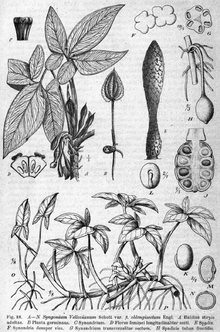Syngonium podophyllum
| Syngonium podophyllum | |
|---|---|
 | |
| Syngonium podophyllum var. podophyllum[1] | |
| Scientific classification | |
| Kingdom: | Plantae |
| (unranked): | Angiosperms |
| (unranked): | Monocots |
| Order: | Alismatales |
| Family: | Araceae |
| Subfamily: | Aroideae |
| Tribe: | Caladieae |
| Genus: | Syngonium |
| Species: | S. podophyllum |
| Binomial name | |
| Synogonium podophyllum Schott | |
| Synonyms[2] | |
| |
Syngonium podophyllum is a species of aroid, and commonly cultivated as a houseplant. The species is native to a wide region of Latin America from Mexico to Bolivia, and naturalized in the West Indies, Florida, Texas, Hawaii, and other places.[2][3][4][5][6][7][8][9][10][11]
Syngonium podophyllum is the most commonly cultivated species in the genus Syngonium, and is often referred to simply as syngonium. It was originally confused with the similar-looking African genus Nephthytis, and this is still used as a common name for the plant. It was given its own genus in 1879.[12] Other common names include:
- Arrowhead plant
- Arrowhead vine
- Arrowhead philodendron
- Goosefoot
- African evergreen[13]
- American evergreen[14]
There are several variegated cultivars, the main differences being in the position and extent of the cream or white markings. Some leaves are almost entirely white, pink or yellow. All parts of the plant are poisonous and cause severe mouth pain if eaten.[15] It is not unusual to find these growing in Sub-tropical Florida landscapes, where homeowners and yard workers need to be aware of the severe skin burning sensations caused by the plants sap containing oxalic acid and the eye damage potential from raphides .[16]



Varieties
Among the wild populations, two varieties are formally recognized:[2][17]
- Syngonium podophyllum var. peliocladum (Schott) Croat - Costa Rica, Panama
- Syngonium podophyllum var. podophyllum - widespread as a native from Mexico to Brazil and Bolivia, as well as Trinidad; naturalized in the West Indies (including the Cayman Islands and the Bahamas), Florida, Texas, Hawaii, Seychelles, Borneo, and Malaysia
References
- ↑ Adolf Engler - Das Pflanzenreich vol. 71 (1920)
- 1 2 3 Kew World Checklist of Selected Plant Families
- ↑ Govaerts, R. & Frodin, D.G. (2002). World Checklist and Bibliography of Araceae (and Acoraceae): 1-560. The Board of Trustees of the Royal Botanic Gardens, Kew.
- ↑ Hammel, B.E. & al. (2003). Manual de Plantas de Costa Rica 2: 1-694. Missouri Botanical Garden Press, St. Louis.
- ↑ Acevedo-Rodríguez, P. & Strong, M.T. (2005). Monocotyledons and Gymnosperms of Puerto Rico and the Virgin Islands. Contributions from the United States National Herbarium 52: 1-415.
- ↑ Hernandez, J. (2007). In Hawaiian rainforests: exotic aroid ecologies. Aroideana 30: 91-97.
- ↑ Nelson Sutherland, C.H. (2008). Catálogo de las plantes vasculares de Honduras. Espermatofitas: 1-1576. SERNA/Guaymuras, Tegucigalpa, Honduras.
- ↑ Hokche, O., Berry, P.E. & Huber, O. (eds.) (2008). Nuevo Catálogo de la Flora Vascular de Venezuela: 1-859. Fundación Instituto Botánico de Venezuela.
- ↑ Arruda Pontes, T., Moreira de Andrade, I. & Alves, M. (2010). Flora da Usina São José, Igarassu, Pernambuco: Araceae. Rodriguésia; Revista do Instituto de Biologia Vegetal, Jardim Botânico e Estaçao Biologica do Itatiaya 61: 689-794.
- ↑ Oppenheimer, H. (2011). New Hawaiian plant records for 2009. Bishop Museum Occasional Papers 220: 5-10.
- ↑ Acevedo-Rodríguez, P. & Strong, M.T. (2012). Catalogue of seed plants of the West Indies. Smithsonian Contributions to Botany 98: 1-1192.
- ↑ http://www.arhomeandgarden.org/plantoftheweek/articles/Arrowhead_Philodendron.htm
- ↑ http://www.desert-tropicals.com/Plants/Araceae/Syngonium_podophyllum.html
- ↑ "Syngonium podophyllum". Natural Resources Conservation Service PLANTS Database. USDA. Retrieved 7 December 2015.
- ↑ http://www.ces.ncsu.edu/depts/hort/consumer/poison/Syngopo.htm
- ↑ "University of Florida advisory Poisonous Garden Plants" (PDF).
- ↑ Biota of North America Program, 2013 county distribution map